Are you overwhelmed by your never-ending to-do list and struggling to keep up with your busy schedule? Do you find yourself constantly rushing through tasks, feeling stressed, and having difficulty staying focused?
If so, then you're not alone.
The fast-paced nature of modern life can often leave us feeling stressed and overwhelmed, struggling to manage our time effectively.
But fear not — there's a solution! In this article, we'll explore time management techniques that can help you regain control of your time and achieve more.
Benefits of using time management techniques
Time management techniques have numerous benefits, including increased productivity, reduced stress, and easier goal achievement. Let's explore these benefits further and discover how time management can transform your workday.
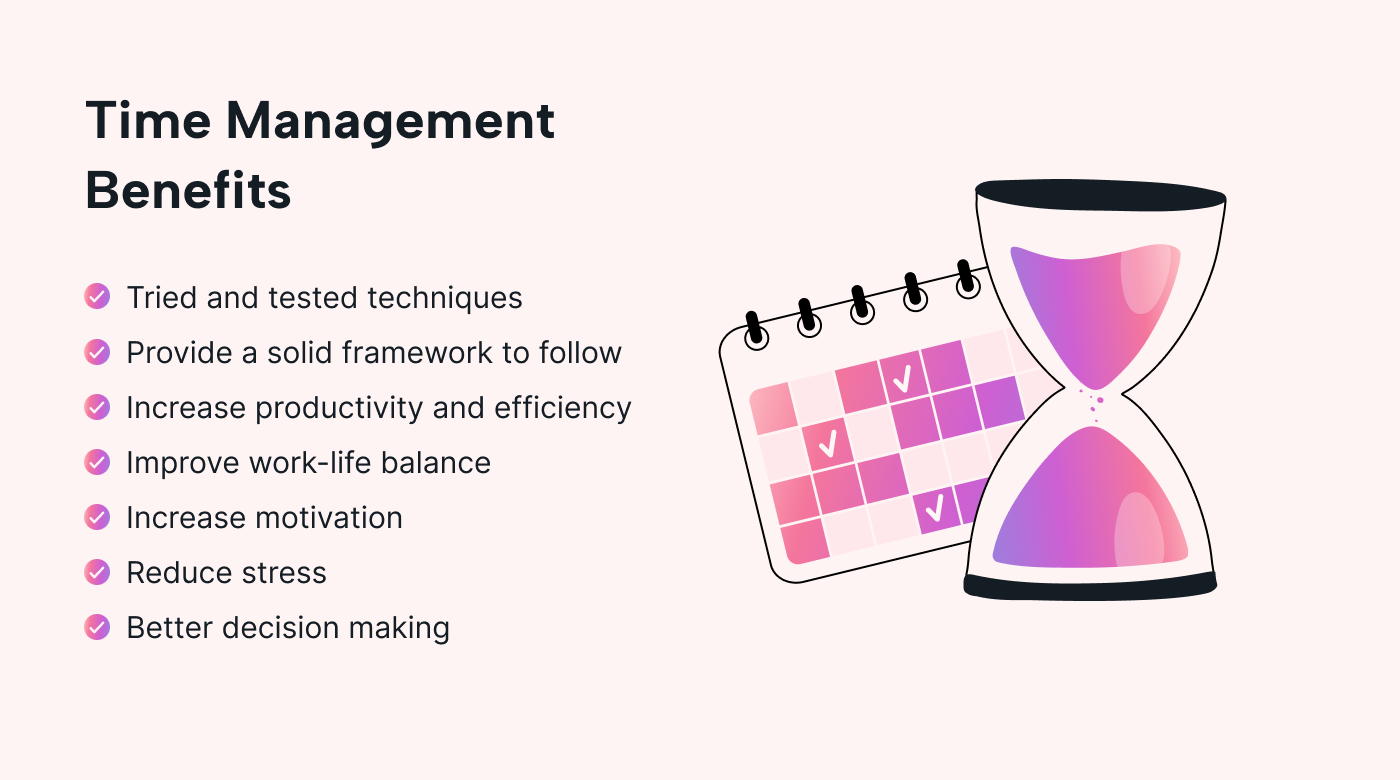 |
Tried and tested techniques
Time management techniques have been around for enough time and are based on sound principles. They've been tested by many people, and proven over time, so you don't have to reinvent the wheel.
Provide a solid framework to follow
Time management techniques help structure your day, which can be especially helpful when you have a surplus of tasks. Following a framework can help you ensure that you progress on all of your tasks.
Increase productivity and efficiency
Time management techniques help people stay focused, organized, and efficient, leading to higher productivity levels. In fact, research shows that the average person will try 13 time management methods to find the right one for them.
From the Pomodoro technique to the Eisenhower Matrix, the Rapid Planning Method, and more, time management techniques can help you set realistic goals, prioritize tasks, and use your time more efficiently.
Improve work-life balance
Time management techniques can help you avoid overworking yourself and ensure that you make time for both work and other important aspects of your life, such as your family, friends, and hobbies.
Increase motivation
Breaking down big tasks into smaller, time-boxed tasks can make you feel more motivated to tackle your to-do list. It can also keep you from feeling overwhelmed with everything that you need to get done.
Seeing your progress on smaller tasks can give you a sense of accomplishment and the motivation to keep going.
Reduce stress
Stress is a vicious cycle, especially when it comes to managing your workday. The less productive or in control of your to-do list you feel, the more stressed and overworked you’re likely to become.
The numbers prove it. Research by Zippia shows that:
- Right now, 82% of individuals don’t have a time management system
- And that means they have no clarity on what they’re spending their time on — The average worker spends 51% of of the day on tasks with little to no value
- Unsurprisingly, this leaves only 20% of people feeling like they workday is under their control
Having a plan for your day and using time management techniques can help you reduce the stress and anxiety that can come from feeling overwhelmed by your to-do list. When you know what you need to do and have a plan for how to accomplish it, you can avoid last-minute rushes and feel more in control of your workload.
Better decision making
Did you know that multitasking is the 3rd most commonly cited productivity blocker, with 31% of Zapier survey respondents saying they experience this issue?
Instead, time management techniques can help you prioritize tasks and make more informed decisions about how to spend your time.
Techniques like the Eisenhower Matrix can help you ensure that you focus on the urgent tasks first and avoid wasting time on the less important tasks. This can help you make better decisions about how to manage your time and ensure that you are progressing on the things that matter most.
13 time management techniques
Time management skills are crucial for success in any field. And fortunately, there are many techniques available to help people manage their time effectively. Here are some popular time management techniques, along with brief explanations of them:
1. Pareto Principle (80/20 Rule)
You may have heard of the 80/20 rule, which states that 80% of outcomes result from 20% of inputs. This means that focusing on the most important tasks can help you achieve better results.
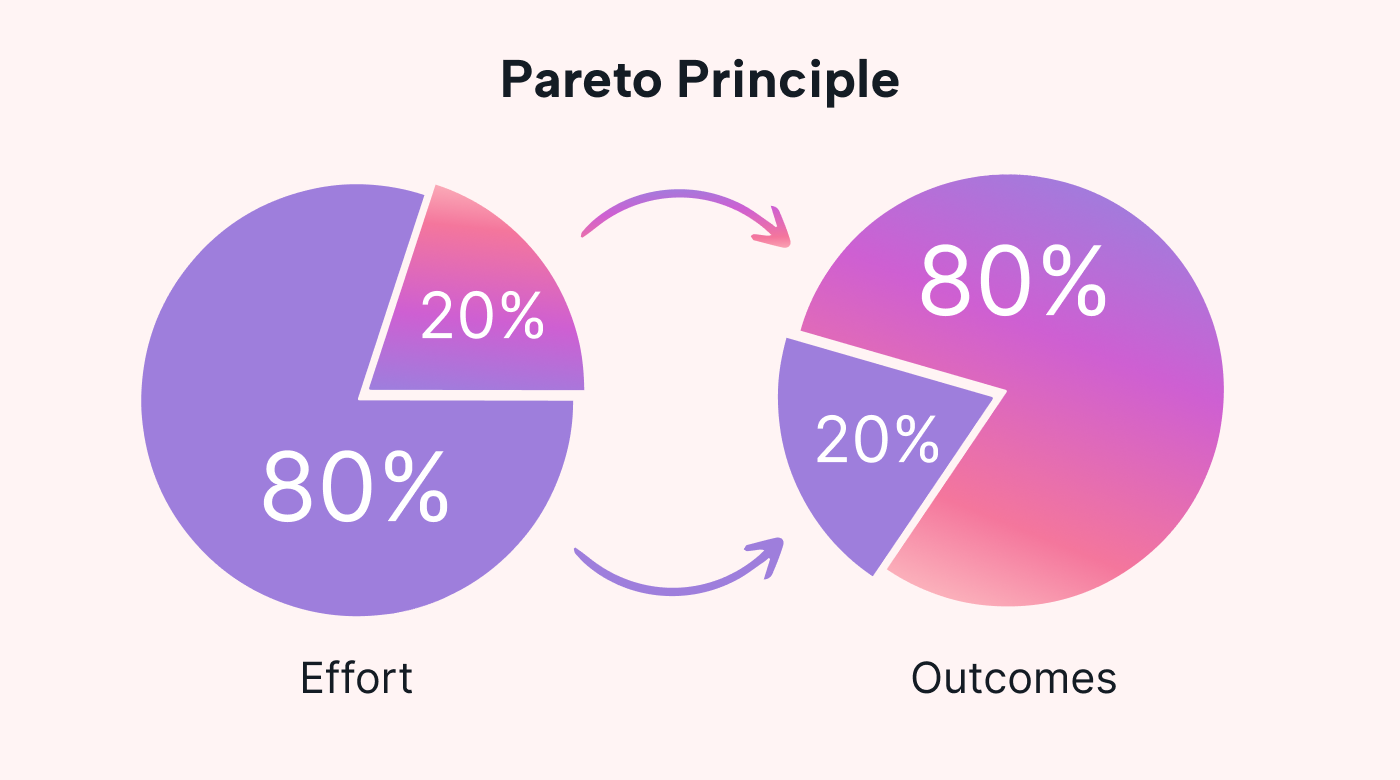 |
That’s the principle — so how do you put it into action?
Try this: if you have a long to-do list, focus on the two or three most important tasks first. To choose these tasks, gain a sense of how much benefit you’ll gain from performing these tasks as a priority.
It’s not just about how much you accomplish — with the Pareto principle, it’s also about the value of what you complete.
2. Parkinson's Law
Have you ever noticed that work seems to expand to fill the time available for its completion? That's Parkinson's Law in action. Fortunately, you can use this to your advantage by setting deadlines for yourself to prevent tasks from dragging on.
Giving yourself a specific amount of time to complete a task will help improve your focus and efficiency.
3. Pomodoro Technique
The Pomodoro Technique is perfect for those of us who get easily distracted. Set a timer for 25 minutes (a Pomodoro), and work on a task until the timer goes off. Then, take a short break before starting the next Pomodoro.
There’s a reason why this technique works so well. As the College of New Caledonia found:
“We learn best when we are fully engaged in a task, but this can be mentally exhausting. With this intensity breaks are important. During the longer breaks our brains are assimilating the new information and resting for the next round.”
4. 3/3/3 Method
This method is a great way to stay organized and focused throughout the day.
Spend three minutes planning your tasks for the day, three minutes reviewing your progress at the end of each hour, and three minutes reflecting on your achievements at the end of the day. The 3/3/3 Method is like a little check-in with yourself to make sure you're on track.
5. ABCs
This technique is all about prioritization.
Divide your tasks into three categories: A (urgent and important), B (important but not urgent), and C (not urgent and not important). Focus on your "A" tasks first to avoid getting bogged down by the less important tasks.
6. Rapid Planning Method (RPM)
The RPM method is all about setting goals and breaking them down into actionable steps. It's like a roadmap for your day. With 3% of people relying on this method, It’s the second most commonly used technique behind time blocking, and it requires some introspection.
You’ll need to define the outcome, understand the “why” behind it, and outline what you’ll need to do to achieve it. Once you’re done with this exercise, you can quickly and easily map out tasks based on their priority, order, and set deadlines for their achievement.
7. Time Blocking
Time blocking is like setting appointments with yourself. This simple time management technique involves scheduling your day into blocks of time dedicated to specific tasks. You estimate how long each task will take and assign it to a time block.
This helps you avoid distractions and focus on one task at a time in chunks of time, increasing your productivity.
8. Eat the Frog
This time management strategy is all about tackling the most difficult task first thing in the morning. It's like taking a shot of espresso for your to-do list. By getting the most challenging stuff out of the way first (like eating a frog), you'll be more motivated and productive throughout the day.
9. Eisenhower Matrix
The Eisenhower Matrix is a great way to prioritize your tasks. Divide your tasks into four categories: urgent and important, important but not urgent, urgent but not important, and not urgent and not important.
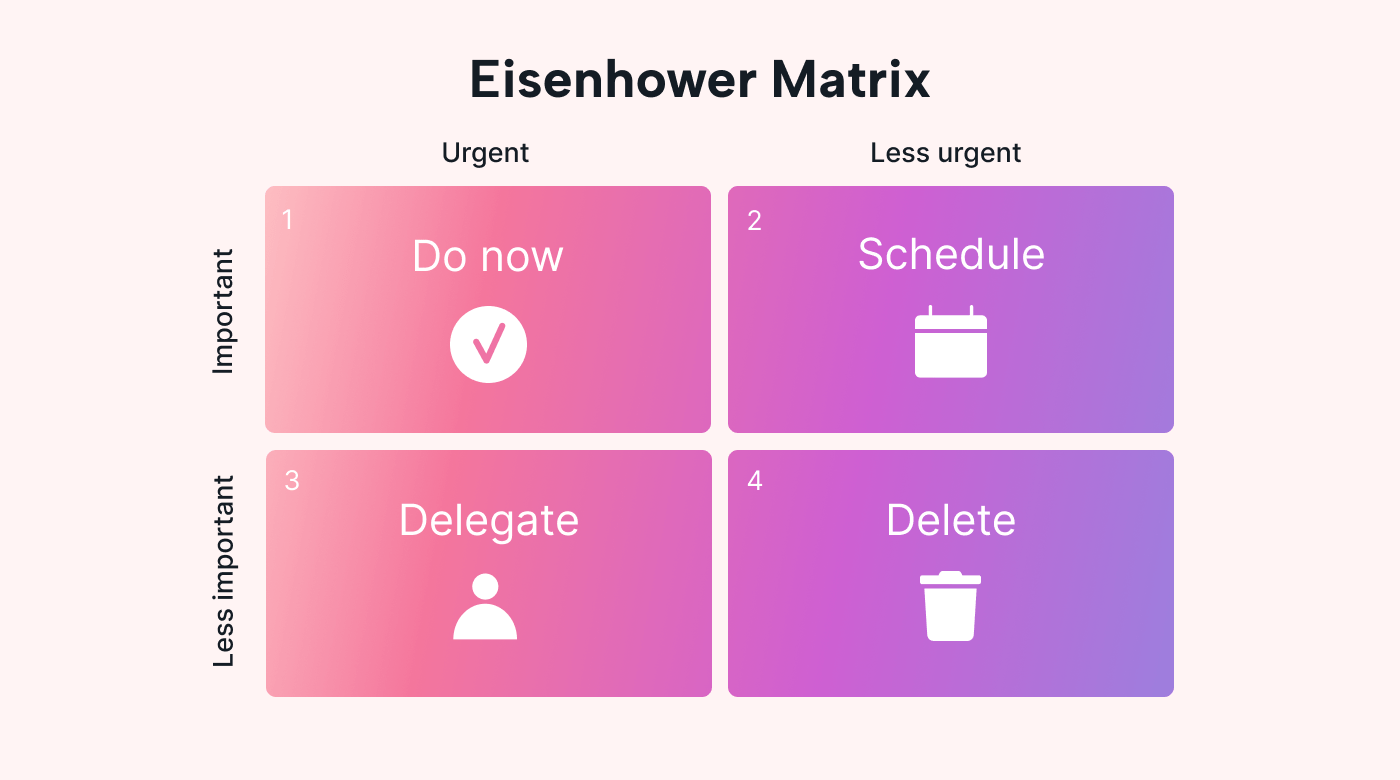 |
Across the board, people agree: the Eisenhower Matrix works. A study of 500 employees by Acuity Training found that:
- The Eisenhower time management technique is the most successful (and popular) out there.
- Every single person who reported using this methodology felt their work was under their control for 4 to 5 days per week.
- Eisenhower’s reason for success is because it runs counter to the “dealing with whatever comes up” as a makeshift time management technique.
10. Getting Things Done (GTD)
The GTD method is all about staying organized and focused. Capture all your tasks and ideas, clarify what needs to be done, organize your tasks into actionable steps, review your tasks regularly, and take action on your most important tasks.
11. The Two-Minute Rule
This rule is perfect for those small tasks that always seem to pile up. If a task can be completed in two minutes or less, do it immediately. This is a great way to stay on top of your to-do list and avoid procrastination.
12. Task Batching
Task batching is like grouping similar tasks together. By doing similar tasks at the same time, you'll be more efficient and less distracted.
13. Time-boxing
Time-boxing is like setting a deadline for each task. It's a great way to stay focused and avoid distractions. Set a specific amount of time for each task, and work on it until the timer goes off.
Time management best practices
Keep the following points in mind to get the most out of your chosen time management technique:
Automate
Automating repetitive tasks can save you a lot of time and energy. You can use tools to automate tasks like email filtering, file backup, and social media posting. By automating these tasks, you can focus on more important tasks that require your attention and creativity.
Delegate
Delegating tasks to others can not only free up your time but also help you build a team and develop your leadership skills.
Identify tasks that can be done by others, and delegate them to team members, freelancers, or virtual assistants. This will help you focus on tasks that require your expertise and creativity while also empowering others to take ownership of their work.
Plan ahead
Planning ahead and prioritizing your tasks based on their importance and urgency can help you stay organized and avoid last-minute stress. Use a planner or task management tool to plan your day, week, or month in advance. This will help you remain on track and avoid distractions.
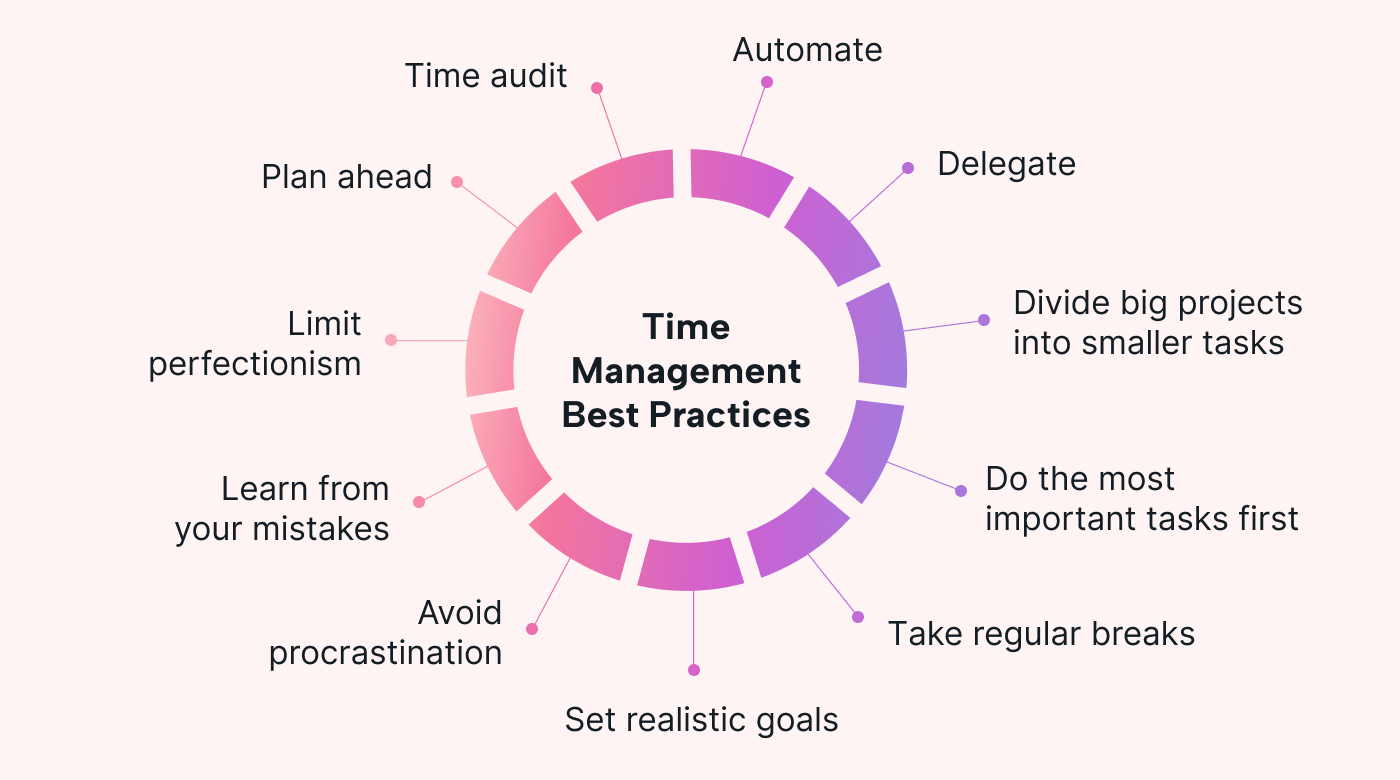 |
Limit perfectionism
While it's important to strive for excellence, don't let the pursuit of perfection — which can lead to procrastination, overthinking, and burnout — hold you back or slow you down. Instead, focus on making progress and learning from your mistakes. Set realistic goals, and don't be too hard on yourself if you don't achieve them as expected.
Take regular breaks
Taking regular breaks can recharge your batteries and refresh your mind. Research shows that breaks can improve focus, productivity, and creativity. You can take short breaks every hour or two or longer breaks during the day. Use this time to do something relaxing or enjoyable, like taking a walk, listening to music, or reading a book.
Set realistic goals
Setting realistic goals that challenge you but are also achievable can help you stay motivated and avoid burnout. Set SMART goals to ensure they are specific, measurable, achievable, relevant, and time-bound. This will help you stay focused and track your progress.
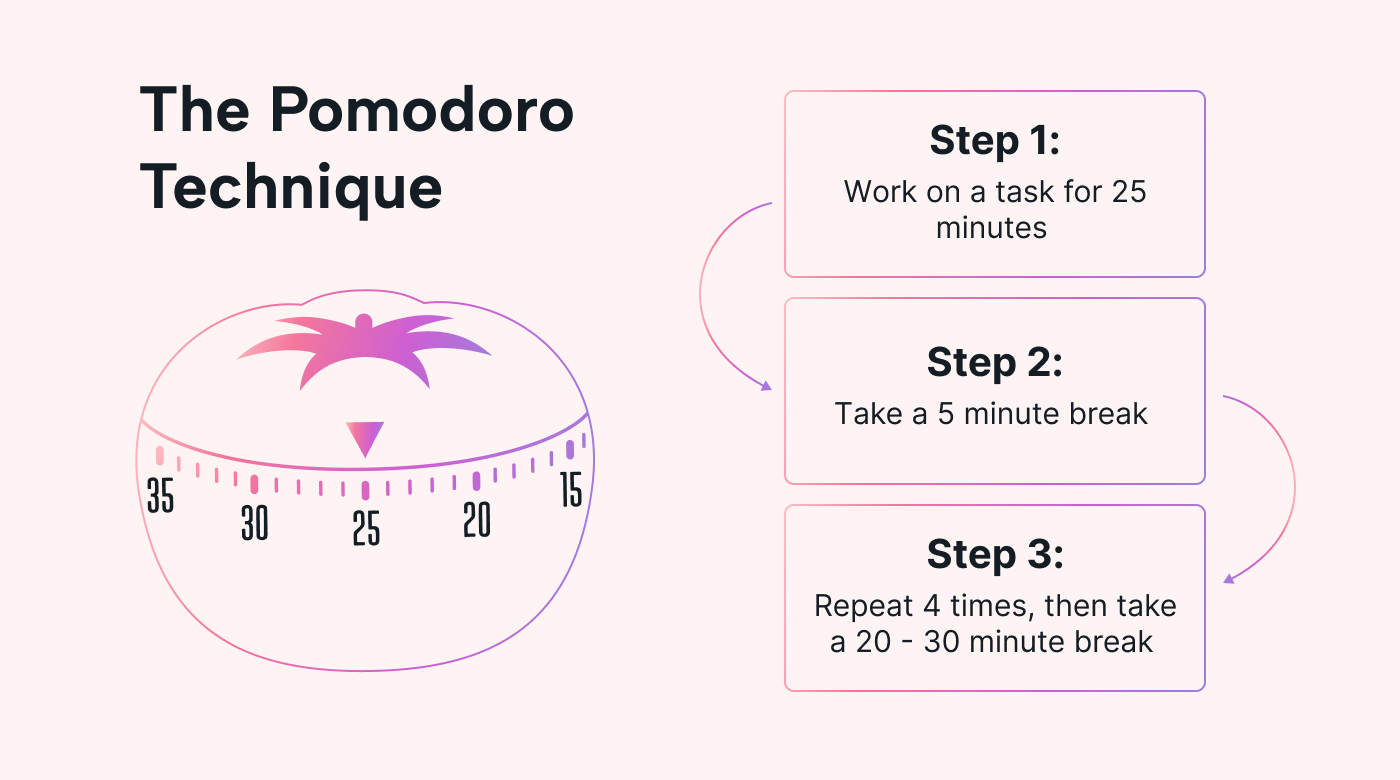 |
Avoid procrastination
Procrastination can be a major obstacle to getting the most out of your valuable time. To avoid it, break your tasks down into smaller, manageable steps, and tackle them one by one. Eliminate distractions by turning off your phone, closing your email, or using a website blocker.
Use the Pomodoro technique to work in short bursts and take regular breaks. Or there's the 5-second rule: When you catch yourself procrastinating, countdown from 5 and take action immediately to overcome the urge to delay.
Learn from your mistakes
Learning from your mistakes and using them as opportunities for growth and improvement can help you become more resilient and successful. Don't be too hard on yourself if you make a mistake or fail at something. Instead, focus on what you can learn from the experience and how you can improve in the future.
You can also use feedback from others to identify areas of improvement and take action to address them.
Do the most important tasks first
Prioritizing your tasks can help you stay focused and avoid getting sidetracked by less important ones. Identify the urgent tasks, and work on them first thing in the morning when your energy and focus are at their highest. This will help you make progress on them and keep your stress levels down throughout the day.
Time audit
Conducting a time audit can help you identify where your time is being spent and how you can optimize it. Track your time for a week or two, and analyze how you spend it. Look for patterns and areas where you can make improvements.
For example, you may find that you spend too much time on social media or email or that you could benefit from delegating some tasks to others. Use this information to make adjustments and optimize your time management.
Divide big projects into smaller tasks
Dividing big projects into smaller tasks is a critical tactic to help you achieve your goals and avoid feeling overwhelmed.
 |
When faced with a large project, it can be challenging to know where to start or to see a clear path forward. By breaking the project down into smaller, more manageable tasks, you can make progress in a more structured and organized way.
Implement time management techniques with Motion
Trying to juggle multiple tasks at once can be a daunting task, and it's easy to feel like you're not making any progress. But with the right time management technique and tools, you can make progress in a more structured and organized way.
Motion is an intuitive, powerful time management tool that can help you and your team improve your time management. Our Intelligent Calendar provides a way to see daily schedules with just one click so that you have your tasks prioritized by importance and know exactly what to do first, second, etc.
Our software also reminds you of upcoming deadlines and warns you if one is about to be missed. This helps keep you on track with your tasks.
You can achieve more in less time by taking control of your time and utilizing tools like Motion. So what are you waiting for? It's time to start achieving your goals with Motion.
Sign up for a free 7-day trial today.
Time management FAQs
What is the most powerful time management technique?
The most powerful time management technique is subjective and depends on your preferences and needs. However, some effective techniques include the Pomodoro Technique, the Eisenhower Matrix, and the Getting Things Done (GTD) method.
What is the simplest time management system?
The simplest time management systems are those that are easy to understand and implement. One such system is the "To-Do List," which involves writing down all the tasks that need to be done and prioritizing them based on their importance and urgency.
What are the 4 D's of time management?
The 4 D's of time management are as follows:
- Do it: Complete the task immediately if it takes less than two minutes.
- Delegate it: Assign the task to someone else if possible.
- Defer it: Postpone the task to a later time or date.
- Delete it: Eliminate the task if it is not necessary or important.






